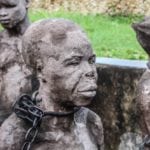 Our World
Our World  Our World
Our World  Miscellaneous
Miscellaneous 10 Intriguing Origins of Popular Carnival Rides
 Weird Stuff
Weird Stuff Ten Unexpected Discoveries Involving Vomit
 Movies and TV
Movies and TV 10 Actors Who Almost Didn’t Take Career-Defining Roles
 Technology
Technology 10 Little-Known Shifts in Computer Science
 Religion
Religion 10 Catholic Histories That Reveal Acceptance of Abortion and Contraception
 Politics
Politics 10 Lesser-Known “First and Only” Facts about U.S. Presidents
 Miscellaneous
Miscellaneous 10 Things You May Not Know about the Fourth of July
 History
History 10 Shocking and Gruesome Founding Father Facts They Don’t Teach in School
 Crime
Crime The Ten Most Vicious Los Angeles Killers
 Our World
Our World 10 Surprising Secrets of Notre Dame Cathedral
 Miscellaneous
Miscellaneous 10 Intriguing Origins of Popular Carnival Rides
 Weird Stuff
Weird Stuff Ten Unexpected Discoveries Involving Vomit
Who's Behind Listverse?

Jamie Frater
Head Editor
Jamie founded Listverse due to an insatiable desire to share fascinating, obscure, and bizarre facts. He has been a guest speaker on numerous national radio and television stations and is a five time published author.
More About Us Movies and TV
Movies and TV 10 Actors Who Almost Didn’t Take Career-Defining Roles
 Technology
Technology 10 Little-Known Shifts in Computer Science
 Religion
Religion 10 Catholic Histories That Reveal Acceptance of Abortion and Contraception
 Politics
Politics 10 Lesser-Known “First and Only” Facts about U.S. Presidents
 Miscellaneous
Miscellaneous 10 Things You May Not Know about the Fourth of July
 History
History 10 Shocking and Gruesome Founding Father Facts They Don’t Teach in School
 Crime
Crime The Ten Most Vicious Los Angeles Killers
8 Atrocities Committed in the Name of Religion
Throughout history religion has been used as an excuse, or driving force, for some of the worst atrocities imaginable. From pre-history to modern history, religion is, for many people, just an excuse to kill other people. This list highlights eight of the worst atrocities (but not necessarily the top 8).

Human sacrifices were still occurring in Buddhist Burma in the 1850s. When the capital was moved to Mandalay, 56 “spotless” men were buried beneath the new city walls to sanctify and protect the city. When two of the burial spots were later found empty, royal astrologers decreed that 500 men, women, boys, and girls must be killed and buried at once, or the capital must be abandoned. About 100 were actually buried before British governors stopped the ceremonies.

Members of lndia’s Thuggee sect strangled people as sacrifices to appease the bloodthirsty goddess Kali, a practice beginning in the 1500s. The number of victims has been estimated to be as high as 2 million. Thugs were claiming about 20,000 lives a year in the 1800s until British rulers stamped them out. At a trial in 1840, one Thug was accused of killing 931 people. Today, some Hindu priests still sacrifice goats to Kali.

The Mountain Meadows massacre was a mass killing of the Fancher-Baker wagon train at Mountain Meadows in Utah Territory on September 11, 1857, by a group of Mormons and Paiute Indians. The Arkansas emigrants were traveling to California shortly before Utah War started. Mormons throughout the Utah Territory had been mustered to fight the invading United States Army, which they believed was intended to destroy them as a people. Initially intending to orchestrate an Indian massacre, two men with leadership roles in local military, church and government organizations, Isaac C. Haight and John D. Lee, conspired for Lee to lead militiamen disguised as Native Americans along with a contingent of Paiute tribesmen in an attack.
The emigrants fought back and a siege ensued. Intending to leave no witnesses of Mormon complicity in the siege and avoid reprisals complicating the Utah War, militiamen induced the emigrants to surrender and give up their weapons. After escorting the emigrants out of their fortification, the militiamen and their tribesmen auxiliaries executed approximately 120 men, women and children.

The Medieval Inquisition is a series of Inquisitions (Roman Catholic Church bodies charged with suppressing heresy) from around 1184, including the Episcopal Inquisition (1184-1230s) and later the Papal Inquisition (1230s). It was in response to large popular movements throughout Europe considered apostate or heretical to Christianity, in particular Catharism and Waldensians in southern France and northern Italy. These were the first inquisition movements of many that would follow.
Torture was used after 1252. On May 15, Pope Innocent IV issued a papal bull entitled Ad exstirpanda, which authorized the use of torture by inquisitors. The Inquisitors were forbidden to use methods that resulted in bloodshed, mutilation or death. One of the more common forms of medieval inquisition torture was known as strappado. The hands were bound behind the back with a rope, and the accused was suspended this way, dislocating the joints painfully in both arms. Weights could be added to the legs dislocating those joints as well.
The organization is still active today under the name of the Congregation for the Doctrine of the Faith. Prior to becoming Pope Benedict XVI, Cardinal Ratzinger was the head of the congregation.

When Puritans settled in Massachusetts in the 1600s, they created a religious police state where doctrinal deviation could lead to flogging, pillorying, hanging, cutting off ears, or boring through the tongue with a hot iron. Preaching Quaker beliefs was a capital offense. Four stubborn Quakers defied this law and were hanged. In the 1690s fear of witches seized the colony. Twenty alleged witches were killed and 150 others imprisoned.

Christians were first, and horribly, targeted for persecution as a group by the emperor Nero in 64 AD. A colossal fire broke out at Rome, and destroyed much of the city. Rumors abounded that Nero himself was responsible. To divert attention from the rumors, Nero ordered that Christians should be rounded up and killed. Some were torn apart by dogs, others burnt alive as human torches. Over the next hundred years or so, Christians were sporadically persecuted. Then in the mid-third century, emperors initiated even more intensive persecutions. This, “The Great Persecution”, is considered the largest. Beginning with a series of four edicts banning Christian practices and ordering the imprisonment of Christian clergy, the persecution intensified until all Christians in the empire were commanded to sacrifice to the gods or face immediate execution. This persecution was to be the last, as Constantine I soon came into power and in 313 legalized Christianity.

The Aztecs began their elaborate theocracy in the 1300s and brought human sacrifice to a golden era. About 20,000 people were killed yearly to appease gods — especially the sun god, who needed daily “nourishment” of blood. Hearts of sacrifice victims were cut out, and some bodies were eaten ceremoniously. Other victims were drowned, beheaded, burned or dropped from heights. In a rite to the rain god, shrieking children were killed at several sites so that their tears might induce rain. In a rite to the maize goddess, a virgin danced for 24 hours, then was killed and skinned; her skin was worn by a priest in further dancing. One account says that at King Ahuitzotl’s coronation, 80,000 prisoners were butchered to please the gods.

Islamic jihads (holy wars), mandated by the Koran, killed millions over 12 centuries. In early years, Muslim armies spread the faith rapidly: east to India and west to Morocco. Then splintering sects branded other Muslims as infidels and declared jihads against them. The Kharijis battled Sunni rulers. The Azariqis decreed death to all “sinners” and their families. In 1804 a Sudanese holy man, Usman dan Fodio, waged a bloody jihad that broke the religious sway of the Sultan of Gobir. In the 1850s another Sudanese mystic, ‘Umar al-Hajj, led a barbaric jihad to convert pagan African tribes.
This article is licensed under the GFDL because it contains quotations from the Wikipedia articles: Mountain Meadow Massacrew, and Medieval Inquisition. Other sources: Religion’s Death Toll, by James A. Haught [1990]








